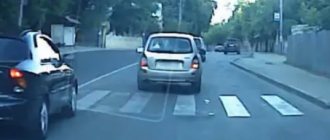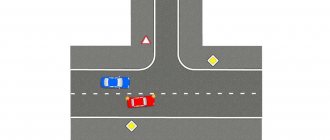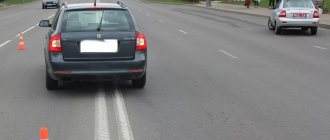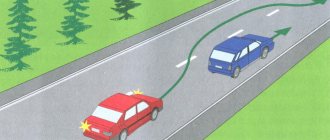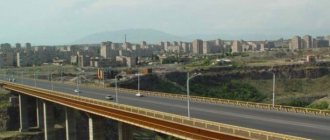Overtaking a vehicle on the road always requires special attention to surrounding details. Driving on the main road provides several benefits to the driver, and staying ahead at an intersection is one of them.
Dear readers! Our articles talk about typical ways to resolve legal issues, but each case is unique. If you want to find out how to solve your particular problem, please use the online consultant form on the right or call. It's fast and free!
Is it possible to overtake at an intersection on the main road?
There are two types of intersections - controlled and unregulated. For those that are regulated using signals, it does not matter which road the vehicle is moving on - the main or secondary one. The signal allows or prohibits movement. Advancement is prohibited here.
Unregulated road intersections can also be located on a main or secondary road. When continuing to drive in such areas, you should pay special attention to the signs; the main road may change its direction.
Overtaking a vehicle in an area without a traffic light or traffic controller can only be done on the main road. It will rarely be possible to perform such a maneuver in a populated area, but such sections may also occur on the highway. If there is a continuous marking 1.1 in front of the intersection, crossing it is prohibited.
Subtleties of traffic rules: can you deprive your license for overtaking in a permitted place?
Experts named several controversial situations on the road that could lead to punishment, although, at first glance, the situation seems obvious.
Let's imagine a situation: a car is driving along city side streets, enters a two-way road, and comes across an illegally parked van that is unloading boxes at a store. The driver taxis through the broken line into the oncoming lane, drives to the nearest intersection and stops at the traffic light.
If you read the traffic rules, you can discover subtleties - on some sections of the road it is prohibited to overtake, even when there are intermittent permitting markings. Paragraph 11.4 states that overtaking is prohibited at controlled and unregulated intersections when driving on a road that is not the main one, as well as at pedestrian crossings, wherever they are located.
Dangerous maneuvers should not be undertaken on bridges, in tunnels, in front of railway crossings, or in situations where visibility is limited, write aif.ru.
Let's imagine another situation: a driver approaches a traffic light on a two-lane road and runs into a small traffic jam, the tail of which stretches for fifty meters. And the cars turn right, and the driver needs to get to the free left side. He won’t hurt anyone if he drives at a speed of 25 km/h through the free lane of oncoming traffic ahead of the traffic jam and makes an authorized turn at the traffic light, but in the middle of this 50-meter section there is a pedestrian crossing. And this must be taken into account, because if there is a traffic police car in a traffic jam, the crew of which witnesses the passage through a pedestrian crossing while overtaking the traffic jam, then the violator will face a fine of five thousand rubles or deprivation of rights under Article 12.15 of the Code of Administrative Offenses of Russia for a period of four to six months.
In this case, the driver will violate two paragraphs of Article 11 of the Traffic Rules: he overtook at a pedestrian crossing; overtook, “on completion of which he will not be able, without creating a danger to traffic and interference with the overtaken vehicle, to return to the previously occupied lane.” The traffic jam will prevent you from returning, which means you can’t overtake.
Inspectors often use such traps to punish a completely law-abiding motorist for driving safely.
There are also plenty of traps of this kind on country roads. Long highways are often interrupted by pedestrian crossings, which are located in the forest, between small settlements. Sometimes they are not marked with signs, and only a badly worn road zebra crossing indicates their presence. For example, a motorist looked into the distance, did not see any prohibiting signs, began to overtake across a broken line, caught up with the car he was overtaking and suddenly noticed a pedestrian crossing sign. Naturally, he continues to overtake, although the traffic rules in this situation oblige him to press the brakes, let the overtaken car go ahead and move into his lane so as not to get into an empty zebra crossing. These actions may result in an accident.
The situation is very controversial: on the one hand, traffic rules are the law, and inspectors who, for example, are on duty in the bushes at the time of the incident and film trapped drivers, are formally right. On the other hand, the law does not tolerate unreasonable application; in this case, it is important not to turn traffic rules into absurdity, but to be guided by common sense, because the law, first of all, requires measures to ensure road safety.
Situations when overtaking at an intersection is prohibited
Even in the permitted case of passing a passing vehicle, there are still controversial situations. Therefore, you must pay attention to the presence of markings, as well as warning signs before crossing.
Drivers often make the mistake of not paying attention to the change in direction of the main road. According to the traffic rules, changing the direction of the main road at an intersection means that drivers moving along it must follow the rules for following equivalent roads. That is, the vehicle ahead will have the advantage of being on the right, therefore, ahead is prohibited here.
No matter which way the direction changes, priority always remains with the vehicle at the intersection. In addition, if the main road turns left, an accident may occur.
Equivalent intersecting roads are governed by the same rules and do not allow overtaking in this section.
The driver also cannot overtake while on a secondary road. Heavy traffic during rush hour can be confusing for drivers. Driving in two lanes on a secondary road is not a reason to perform this maneuver.
It is also prohibited to advance at intersections where there are pedestrian crossings.
Accident while overtaking at an intersection
The occurrence of an emergency situation when overtaking incorrectly at an intersection is not uncommon. In this case, it is often difficult to find out who is at fault for the accident.
Emergency situations when ahead:
- Overtaking on the main road. To determine the culprit of the accident, you need to refer to the traffic rules, where clause 8.1 states the obligation to give light signals or gestures about the intention to make a turn, as well as the safety of the maneuver being performed. And also clause 11.2, which specifies the rules of advance and it is prohibited to perform a maneuver if a moving vehicle has already begun to detour, or gives a left turn signal, if the car behind has already begun to overtake, or if safe completion of the maneuver is not possible.
- When driving ahead at prohibited intersections, the driver performing the maneuver will always be at fault. When crossing 2 secondary roads, the driver taking the lead will also violate clause 11.4, which indicates the places where such a maneuver is prohibited. When overtaking at the intersection of a 4-lane road, the driver will also be a violator; creating an emergency situation will cost him 4-6 months of deprivation of his license, as specified in clause 9.2 of the traffic rules.
How to avoid accidents when overtaking?
Staying ahead of a vehicle on any section of the road requires a clear assessment of the road situation by the driver. And the correct calculation of all possibilities is one of the main reasons by which an accident can be avoided.
In general, the advice on this matter is quite simple and can apply to any road situation:
- Do not pass another vehicle if you are not sure that the maneuver can be completed safely after the section.
- Overtaking at a fork can only be done if you continue in the direct direction of the main road.
- The intersection is dangerous! You need to pay attention to the signals of cars moving in traffic not only in front, but also behind.
- It is always necessary to give signals of intention to perform a maneuver.
Not allowed into your lane when overtaking traffic jams
Probably everyone is already accustomed to long traffic jams in the morning, when all the people go to work, as a result of which a long line of cars forms. You can lose more than an hour of time, and for many this hour can turn out to be catastrophically important, which is where rash actions and the emergence of controversial conflict situations on the roads begin.
One such incident happened to me the other day. Standard morning traffic jam, I stand like everyone else, slowly moving forward. In the mirror I noticed another reckless driver who decided that he was the smartest and drove into the oncoming lane to overtake. He decided to stand right in front of my car, but I couldn’t stand such impudence and didn’t let him in.
The reaction of the overtaking driver caused even more indignation. He lowered the window and started shouting that I had to let him into my lane, because there was a clause in the traffic rules that stated that I should not interfere with overtaking by my actions, after which he drove on safely and stood a few cars away from me. . Perhaps he was right?
Fines for overtaking at an intersection
According to the Code of Administrative Offenses, overtaking at an intersection in violation of traffic rules carries with it administrative liability and a fine of 5 thousand rubles, as well as possible deprivation of the right to drive vehicles for a period of 4 to 6 months. These figures are as of 2017.
So, as a conclusion, you need to learn the main rules for avoiding a moving car in front at an intersection:
- Traffic rules allow you to advance at an intersection only if the car is following an unregulated section of the intersection of the main and secondary roads.
- A driver who is not sure of the possibility of performing it, or if there is a pedestrian crossing at the intersection, should not perform the maneuver.
- Before advancing, you need to assess the road situation and be sure to give a light signal.
- In the event of an accident, the overtaking driver is most often the culprit.
- Making an anticipatory maneuver at unauthorized intersections carries a fine of 5,000 and deprivation of rights for four or even six months.
And the most important rule - “The slower you go, the further you will go” - don’t forget. Don't rush unless absolutely necessary.
Didn't find the answer to your question? Find out how to solve exactly your problem - call right now: +7 (Moscow) +7 (812) 309-53-42 (St. Petersburg) It's fast and free!
Free online consultation with a car lawyer
Didn't find the answer to your question? Find out how to solve exactly your problem - call right now: +7 (Moscow) +7 (812) 309-53-42 (St. Petersburg) It's fast and free!
Overtaking when driving on the main road
While driving on the main road, a driver can overtake another car at an uncontrolled intersection. However, this is only possible outside populated areas.
Main and secondary roads are present only at unregulated intersections. If a traffic light is installed at an intersection, then both sections of the roadway have the same meaning. Priority in traffic is determined by the traffic light signal.
Before crossing roads there are often continuous markings. It is prohibited to cross it. Accordingly, overtaking is not possible.
If the main road changes direction, going to the right or left, then overtaking other vehicles at such an intersection is prohibited. The rules applicable to intersections of equivalent roads apply here. Accordingly, the car approaching from the right will have priority in passing.
